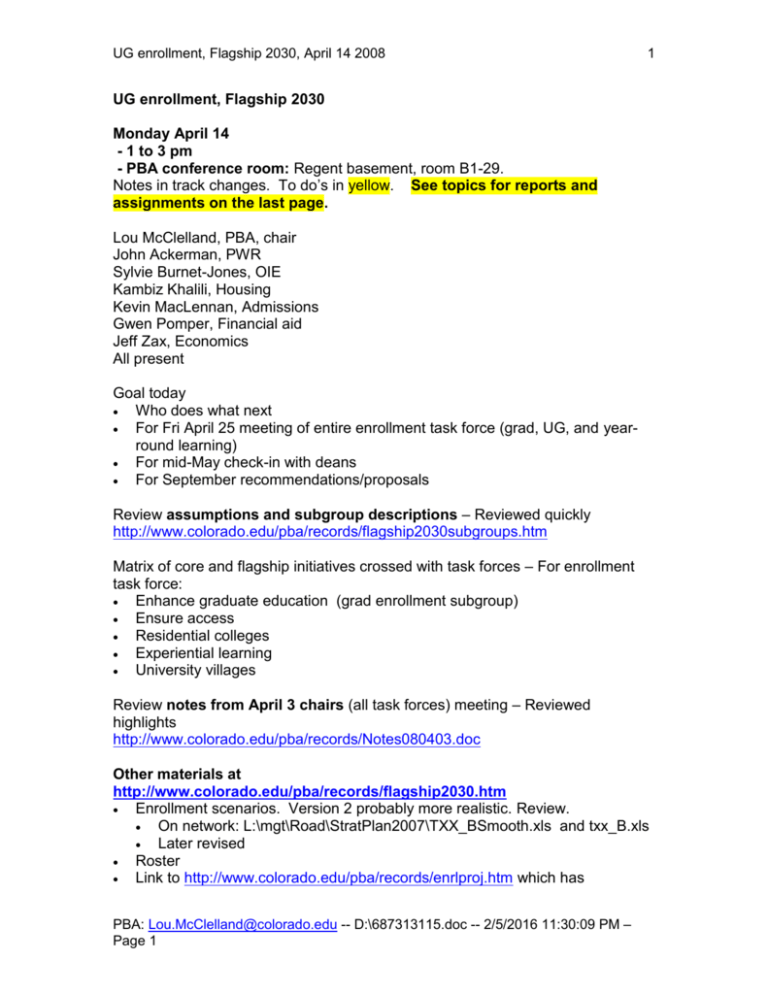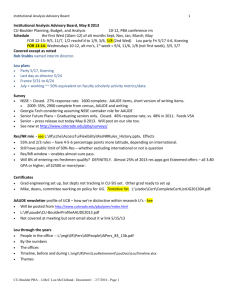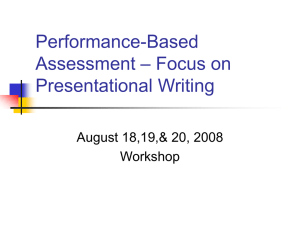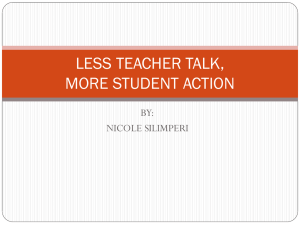Meeting, notes, assignments, and report topics
advertisement

UG enrollment, Flagship 2030, April 14 2008 1 UG enrollment, Flagship 2030 Monday April 14 - 1 to 3 pm - PBA conference room: Regent basement, room B1-29. Notes in track changes. To do’s in yellow. See topics for reports and assignments on the last page. Lou McClelland, PBA, chair John Ackerman, PWR Sylvie Burnet-Jones, OIE Kambiz Khalili, Housing Kevin MacLennan, Admissions Gwen Pomper, Financial aid Jeff Zax, Economics All present Goal today Who does what next For Fri April 25 meeting of entire enrollment task force (grad, UG, and yearround learning) For mid-May check-in with deans For September recommendations/proposals Review assumptions and subgroup descriptions – Reviewed quickly http://www.colorado.edu/pba/records/flagship2030subgroups.htm Matrix of core and flagship initiatives crossed with task forces – For enrollment task force: Enhance graduate education (grad enrollment subgroup) Ensure access Residential colleges Experiential learning University villages Review notes from April 3 chairs (all task forces) meeting – Reviewed highlights http://www.colorado.edu/pba/records/Notes080403.doc Other materials at http://www.colorado.edu/pba/records/flagship2030.htm Enrollment scenarios. Version 2 probably more realistic. Review. On network: L:\mgt\Road\StratPlan2007\TXX_BSmooth.xls and txx_B.xls Later revised Roster Link to http://www.colorado.edu/pba/records/enrlproj.htm which has PBA: Lou.McClelland@colorado.edu -- D:\687313115.doc -- 2/5/2016 11:30:09 PM – Page 1 UG enrollment, Flagship 2030, April 14 2008 2 Enrollment stats since 1877 Buff Futures plan, ‘95 Strategic enrollment plan, ’97 2001 Blue Ribbon with section on market niche Should someone review these plans? No one suggested or volunteered National HS grad projections from WICHE and College Board – Review – Had reviewed quickly at February meeting Revise CO HS grads in our scenarios, to fit WICHE?? Think 2022 is 65 in mine, 60 in WICHE. Yes, DO. DONE, reflected in revised scenario version G at http://www.colorado.edu/pba/records/flagship2030.htm. Now includes private HS grads as well as public. Even so, total for 2030 is lower than that used previously. Also relevant – If, how use? Did not review or discuss On admissions http://www.colorado.edu/pba/adm/ with Colorado pipeline by race/ethnic http://www.colorado.edu/pba/adm/COapps_ethn.htm Academic prep of our apps, admits, matrics over time http://www.colorado.edu/pba/records/acprep/index.htm Other miscellaneous Financial aid Res undergrads FY07 http://www.colorado.edu/pba/adm/rug079.pdf Material on loan debt and repayment Tuition history and peer comparisons http://www.colorado.edu/pba/budget/tuitionfees/index.html Peer comparisons, tuition and more http://www.colorado.edu/pba/peer/index.html Other resources – what use, how? – No discussion AAU freshmen profile esp graphs, other schools with high NR: L:\datalib\Insts\NFR_Profile0708rpt07.xls See – Glanced at A&S $$ model ?? Relevant? See email. Model: L:\mgt\Road\StratPlan2007\A&SEnrollmentGrowthModelv10.xls $ model I did for 2030?? Relevant? L:\mgt\Road\StratPlan2007\Model.xls Retention and graduation rates http://www.colorado.edu/pba/records/time/gradrtIntro.htm Financial aid – Should we make recommendations? See http://www.colorado.edu/pba/adm/ for Cum debt and default rates Characterization of FY07 resident undergrads re aid UC model: Loan, work expectation for every student (even high need), grant fills in the rest. Would need considerably higher resident tuition to do this. Model to calc tuition increase needed not complete. University of California Financing Guide for Students and Parents PBA: Lou.McClelland@colorado.edu -- D:\687313115.doc -- 2/5/2016 11:30:09 PM – Page 2 UG enrollment, Flagship 2030, April 14 2008 3 http://www.universityofcalifornia.edu/admissions/payingforuc/finguide_f r.pdf Master Plan Partnerships: Undergraduate Student Financial Aid and Campus-Based Student Fees, presentation to the University of California Regents, March 2005 http://www.ucop.edu/sas/sfs/docs/regents_presentation.pdf Some discussion – Gwen What does the “world” see – prospective students, parents, HS counselors, press - Brief discussion CDS, common dataset http://www.colorado.edu/pba/cds/cds08/index.htm VSA voluntary system of accountability – new http://www.colorado.edu/pba/VSA/ IPEDS, US government http://nces.ed.gov/collegenavigator/ US News and other publications – admissions ~same as in CDS. Aid more detailed in some. http://colleges.usnews.rankingsandreviews.com/usnews/edu/college/rankings /ranknatudoc_brief.php Admit rate and test scores usually the two keys to characterizing “selectivity” and “academic quality.” What this omits: Who decided to apply, who was guided elsewhere HS performance (vs. test scores) Mission and niche Enrollment management – Reviewed this section National enrollment mgt literature; companies that hire out to colleges, U’s Often refers to undergrads only Usually refers to recruiting and admission, retention, financial aid How other schools do enrl mgt. No recent AAUDE query. Clear that some other IR offices do projections and links to budget. Some may do weekly/incycle admissions analyses too. Here Good working relationships, cross training: UG admissions, financial aid, registrar, bursar. Enrollment prediction group meets alternate weeks, with PBA, admissions, FA, bursar, registration, budget Analytic work largely by PBA working with admissions CCHE admission standard and other state rules have complicated admission decisions in many years Allocations of students, new freshmen, money to colleges – both methods and results are an issue Campus Solutions for interventions Efficiency a la Florida. TTD, hours at degree PBA: Lou.McClelland@colorado.edu -- D:\687313115.doc -- 2/5/2016 11:30:09 PM – Page 3 UG enrollment, Flagship 2030, April 14 2008 4 Relevant AAUDE exchanges, queries Query on pct of UG, grad fiscal year SCH that are in summer. And on pct of FY SCH that are in graduate courses. DONE – Now published on http://www.colorado.edu/pba/records/flagship2030.htm as “AAU: Pct of yearly student credit hours that are a) in summer, b) in graduate level courses.” Results: CU-Boulder is about average on pct of annual undergraduate student credit hours (SCH) taught in summer: UCB 6.0%, median 6.6%. Maximum is 13.5% at UCSB, Florida also over 10% CU-Boulder is very low on pct of annual graduate SCH taught in summer: UCB 4.0%, median 10.2%; Florida, Michigan State, Nebraska, Purdue, and Texas A&M all exceed 15%. The percentage of annual SCH taught in summer is higher at the graduate level for all schools except CU-Boulder and all reporting University of California campuses. 9% of UCB annual SCH are in graduate-level courses. This is the lowest of the 22 reporting AAU’s. Because graduate-level students typically take lower credit loads than undergraduates, the percentage of SCH that are graduate is generally lower than the percentage of student headcount that is graduate. The median is 16%. Florida, Illinois, N Carolina, Berkeley, U Washington, and Wisconsin all exceed 20%. Task force chairs and cochairs were notified of this posting. UG time to degree, credits at degree, and proportions enrolled in summer, enrolled all AY terms – Available this summer we hope Senior and alumni surveys Remainder not discussed NSSE surveys Tuition, noted earlier Freshman profile, ditto Comparisons on grad rates by student group Use of national student clearinghouse to count CU-Boulder students transferring to other AAUs (and to other schools) CU-Boulder bachelors recipients enrolled in graduate work At the meeting we discussed our charge, the enrollment assumptions, and how each member would fit into an overall report. We posed questions about the enrollment assumptions -- in particular – if graduate enrollment falls short of the level in scenario Version 2, would undergraduate enrollment be higher to make up? Those were discussed with Phil and Ric later that week, resulting in the following REVISED assumptions: Grads grow, and grow relative to UG. This is a goal. Resident freshman maintain historic share, 5-7%. This is an OBLIGATION. 35,000 is not a goal or an obligation. Nonresidents and transfers so the overall percentage resident stays 2/3 (if the tuition + state funding gap between R and NR remains) Smooth increases year by year in all. PBA: Lou.McClelland@colorado.edu -- D:\687313115.doc -- 2/5/2016 11:30:09 PM – Page 4 UG enrollment, Flagship 2030, April 14 2008 Results: Freshmen to < 6000, grads to just > 7000, res frosh share up to 6.9, down to 5.3. Total 34,000. OK? Yes, OK. Posted enrollment scenario has been modified accordingly, and 2030 chairs notified -- DONE The revised assumptions then led to a revised enrollment scenario, posted (along with the assumptions) as version G on http://www.colorado.edu/pba/records/flagship2030.htm. This scenario has graduate level enrollment unchanged from version 2, but lower undergraduate enrollment and revised Colorado HS graduate numbers. Notice of the revised scenario was sent to all task force chairs and co-chairs. DONE SEE topics for the report, and assignments, on the last page PBA: Lou.McClelland@colorado.edu -- D:\687313115.doc -- 2/5/2016 11:30:09 PM – Page 5 5 UG enrollment, Flagship 2030, April 14 2008 6 Topics for the report Each person send Lou 1-3 sentences (or more) on their topic before the April 25 all-enrollment task force meeting (10-12, PBA conference room). We will all review/comment/revise all topics before finals. Gwen: Financial aid award policy Kambiz: Housing. Take into account revised scenario, RAP goal, focus on fall new freshmen, freshmen/not mix, other things you mentioned, and what Ric said: - expects will build ~1000 new beds in next 10 years, for some combo of frosh and families - next part of bear creek could serve (or other parts, once it's built) as housing for a yr while XX was renovated - best possible for frosh would be where Engin quad is now, too expensive to renovate/rebuild that Kevin: Managing enrollments Attend to academic preparation Diversity, ballot measures, first gen/income What if can’t get the NR needed Allocation across colleges (see VC update notes) Managing recruiting and admissions Maybe retention and efficiency Jeff and Sylvie (and John?): Retention, value-added, efficiency, teaching students to use the campus efficiently Example of efficiency – reducing average credit hours at degree John PWR inheriting CU 101 – teaching students to use the campus well, to live in a community. Increases ability to recruit, and adds value. Talk to Mike Grant, of UG task force, re overlap University villages, city/University relations. Talk to Carlos Garcia (UMC director), who’s heading work on this in the facilities (I think) task force Lou: Write up re assumptions, change in assumptions, scenarios, maybe the query results PBA: Lou.McClelland@colorado.edu -- D:\687313115.doc -- 2/5/2016 11:30:09 PM – Page 6







